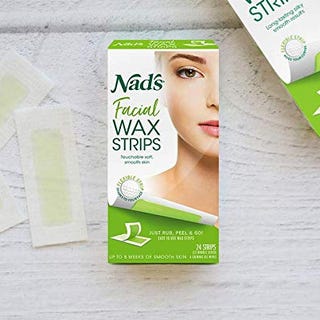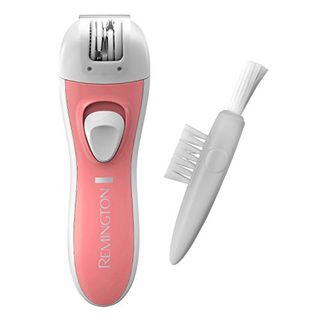If You Shave Peach Fuzz Above Lip Will It Grow Back Stiff
Of all the beauty treatments out there, removing your facial hair is one of the least pleasant activities. "Almost everyone has some facial hair," explains April Franzino, GH beauty director. "It tends to be lighter-colored and less coarse than other body hair."
But de-fuzzing your lip, brows, or chin doesn't have to be difficult or super painful. Facial skin is delicate (and often the first thing people see!), so you'll want to take extra care choose the best facial hair removal method for you. We talked with top experts in the field, from dermatologists to estheticians to get the lowdown on everything from how to properly dermaplane your face to the best epilators, facial razors, face-friendly wax, and dermaplaning tools for facial hair removal.
So if you want to get rid of that fuzz along your upper lip, hairs on your chin, or sprouts between your brows, here's what you need to know about each possible way, plus the best hair removal products for your face.
This content is imported from {embed-name}. You may be able to find the same content in another format, or you may be able to find more information, at their web site.
1. Tweezing
- Best for: Small areas (like stray chin hairs), wiry hairs, or precision tasks (like shaping brows)
- Pain level: Low to medium
- DIY-safe: Yes

Tweezerman
Chances are, plucking is the route with which you're most familiar. After all, tweezers are commonplace in most households so they're the easiest to reach for when you see some strays. "Tweezing is better for smaller, localized areas like your brows and chin," advises Lavanya Krishnan, M.D., a dermatologist based in San Francisco. Just make sure you're diligent about cleaning them.
Birnur Aral, Ph.D., director of the Good Housekeeping Institute Beauty Lab, recommends wiping the tips of tweezers before and after every use with a cotton pad wet with rubbing or ethyl alcohol or an alcohol wipe then letting them dry. Don't wash the tool with regular soap and water — you run the risk of accidentally dropping and damaging it (thanks to slippery hands) or possibly causing the metal to tarnish or oxidize.
And you should always store tweezers inside a protective pouch."Reputable manufacturers often offer a warranty for natural wear and tear, but dropping tweezers will likely ruin the alignment of the tips and void that," Aral adds. And if you're not sure how to properly shape your brows, take a look at our easy eyebrow guide.
2. Waxing
- Best for: Coarse, thick hair and larger areas (like the sideburns or cheeks), for skin that isn't easily irritated
- Pain level: High
- DIY-safe: Sometimes
Another very common method is waxing. Using either soft wax, which is pulled off with cloth strips, or hard wax that simply hardens and is pulled off on its own, a practitioner can remove hairs from your upper lip, cheeks, brows, and chin with ease. But this popular practice isn't for everyone.
"Waxing can cause irritation because the skin can be sensitive to the products being applied to the surface," warns Michelle Yagoda, M.D., a cosmetic surgeon based in New York. "An inexact technique may result in incomplete extraction of the hair follicle and breakage of the hair shaft, so the skin surrounding the hair shaft can then become inflamed." If the retained hair follicle becomes entrapped, it can lead to ingrown hairs. Always read reviews online prior to visiting a new waxing boutique. Your skin will thank you.
With practice and a careful hand, you can also wax at-home. Check out our experts' tips for facial waxing and some of our top-tested wax kits.

SOFT WAX
Natural Hair Removal Organic Wax
Parissa amazon.com
$15.99

NO-HEAT STRIPS
Face Wax Hair Removal Strips

WAX STRIPS
Facial Wax Strips

HARD WAX
Waxing Hair Removal Kit
3. Shaving
- Best for: Fine hair all over the face, and skin that isn't susceptible to razor burn
- Pain level: Low
- DIY-safe: Yes
More and more women are opting to shave their face either in-salon in a process called dermaplaning in-salon or using dermaplaning tools at home to remove hair and exfoliate skin. Shaving is a painless way to remove hair from the face, and "it's just a myth that your hair will grow coarser and more densely after shaving," explains Dr. Krishnan. "The follicle gets cut in half so it feels pricklier, but it's not any thicker."
If you feel most comfortable with a razor, just be sure to take precautions so you can get the smoothest, least irritated finish. "Shave either in the shower or just afterward to allow the skin to soften," advises Anthony Sosnick, shaving expert and founder of Shaveworks.

Join Our Membership Club to Get Unlimited Access
goodhousekeeping.com
This is also helpful if you have thick or coarse hair, as the heat of the steam also softens the strands. You can also apply a pre-shave oil to avoid razor burn.
A good razor matters, too. We suggest using a dedicated razor for facial hair, but if you're opting for a traditional razor, Sosnick recommends picking one with at least two blades, as "they tend to be more targeted for those sensitive areas — and sometimes, fewer blades does the job without the potential for redness and razor burn."
One big tip from dermatologist Michael Swann, M.D.: Don't make passes over the same area several times with your razor. Otherwise, you could irritate your skin — not a great look to have front and center on your face. Once you're done shaving, apply a hydrating moisturizer to soothe your skin.

Silk Touch-Up Dermaplaning Tool


Lumina Personal Hair Remover
Finishing Touch ulta.com
$9.99

Tweezerman Bright Complexion Facial Dermaplaner, 1.978 Ounce
4. Threading
- Best for: Precise tasks on smaller areas like the eyebrows, upper lip, and cheeks
- Pain level: Medium-high
- DIY-safe: No
Eyebrow threading is a very common practice in Middle Eastern and Asian countries that involves using a thin, doubled cotton thread pulled super-taut to roll over spots where you wish to remove hairs, thus pulling them out.
While it isn't quite as labor intensive as plucking hairs one at a time, it works best on smaller areas such as the eyebrows, upper lip and cheeks. And unlike using tweezers, threading is much trickier to try if you've never been trained in it, so head to a salon with a professional who specializes in it for the best results.
5. Depilatories
- Best for: Large areas of hair, like legs and arms
- Pain level: Low-medium
- DIY-safe: Yes

Nad's
Facial Hair Removal Cream
Gone are the days when facial hair removal creams were pungently scented — there are lots of new ones that are gentle and fragrance-free. These creams are applied to the area with unwanted hair, then wiped away along with the hairs themselves.
"Depilatory creams use chemicals such as calcium thioglycolate or potassium thioglycolate, which break disulfide bonds in keratin, thereby weakening the hair," explains Christine Choi Kim, M.D., a dermatologist based in Santa Monica, California. This is one of the most painless forms of hair removal except for some mild tingling or redness as the hair melts away. If you have very sensitive skin, you may experience some irritation: Always do a patch test first to check for any allergies.
6. Epilation
- Best for: Removing hair at the root from larger areas that don't need a precise touch (like underarms, arms, and cheeks)
- Pain level: Medium-high
- DIY-safe: Yes

Remington
Smooth and Silky Facial Epilator
Remington amazon.com
Unlike tweezers, which pull out individual strands, epilation devices pluck out multiple hairs at once — great for snagging errant hairs between waxes. "Think of the device as having multiple little tweezers, all going at once," explains Aral.
It's closest to threading on the pain scale, so more painful than plucking, but not as bad as waxing. Plus, the more you use it, the more accustomed you'll become to the feeling and you may not even consider it painful after regular use. "Don't try to use an epilator to shape your eyebrows," warns Aral. "In between your brows is okay, but be wary of any areas that need a precise touch." She recommends this for hair removal on your chin, side of the face, and even underarms.
7. Topical prescriptions
- Best for: Slowing hair growth temporarily
- Pain level: Low
- DIY-safe: Yes
In addition to the aforementioned over-the-counter or in-salon methods, you can also talk to your dermatologist about trying a topical prescription.
"There are prescription meds like Vaniqa, which is a topical once-a-day treatment used to reduce hair growth," explains Dr. Krishnan. Here's the catch: While it's "very effective," Dr. Krishnan notes that once you stop, the effect wears off and your hair will grow back.
8. Laser hair removal
- Best for: Permanent hair removal for coarse hair or larger areas of hair growth (legs, arms, etc.)
- Pain level: High
- DIY-safe: No
For permanent hair removal, you can try laser hair removal, also known as intense pulse light therapy. "Lasers shoot a certain wavelength of light that's specifically absorbed by the hair follicle itself," says Dr. Krishnan. When that light is absorbed, it's converted into heat which kills the hair follicle.
The advantage this route has over electrolysis is treating a larger portion at a time, while electrolysis (elaborated on below) is individually ablating one follicle at a time — think waxing versus plucking. The downsides: This isn't an ideal route for those with light or fine hairs, and the cost is high, with sessions ranging from $50 to $300. Plus, you may need several sessions to fully destroy the follicles.
While many at-home IPL lasers are available on the market, Gretchen Frieling, MD, a certified dermatopathologist at GFaceMD, says that in-office sessions are more worth your money. "In-home laser hair removal devices are not regulated by the FDA, and therefore, their safety and long-term efficacy are not clear," she says. She adds that at-home treatment can come with serious risks including burns, scarring, and hyperpigmentation if you aren't an appropriate candidate (the procedure works best on dark-haired gals). Plus, Dr. Frieling adds that it's more difficult to cover a lot of surface area with at-home treatments and may take more time, so it's best to leave it to the pros.
9. Electrolysis
- Best for: Permanent hair removal for fine hair or smaller areas of hair growth (upper lip, chin, etc.)
- Pain level: High
- DIY-safe: No
Another permanent option: Electrolysis. This uses concentrated heat to destroy each follicle one at a time to prohibit hairs from growing. This is an ideal method for folks who want permanent hair removal, but can't do laser removal because their hairs are light or fuzzy.
While there are several devices for in-home use, Dr. Frieling says it's best to have the procedure done in a professional setting. "There is always a risk of scarring and permanent skin damage, and even worse, electrocution," she notes. After all, in electrolysis, a needle is used to penetrate the follicle, so a safe and sterile environment outside the home is vital.
Sam Escobar Contributor Sam's enthusiasm for makeup is only rivaled by their love of all things relating to cats.
Nicole Saporita, Good Housekeeping Institute Senior Editor Nicole Saporita is a former senior editor at Good Housekeeping, where she researched, wrote and repored original content for the Good Housekeeping Institute and several other departments including health, travel and family.
This content is created and maintained by a third party, and imported onto this page to help users provide their email addresses. You may be able to find more information about this and similar content at piano.io
If You Shave Peach Fuzz Above Lip Will It Grow Back Stiff
Source: https://www.goodhousekeeping.com/beauty/anti-aging/a24536/a-gentle-way-to-remove-facial-hair/
0 Response to "If You Shave Peach Fuzz Above Lip Will It Grow Back Stiff"
إرسال تعليق